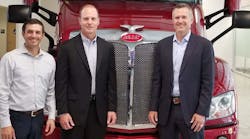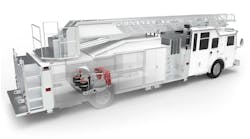With vehicle technology rapidly advancing, many truck manufacturers are creating a presence for themselves in Silicon Valley. One such OE is Paccar, the company that makes Peterbilt and Kenworth trucks.
At Paccar’s Innovation Center in Sunnyvale, California, the company is tapping into the innovative nature of the area in order to make their technology goals a reality.
“Purposeful innovation is continuously engrained into every aspect of our business and it means we will be ready to deliver innovative options to our customers and their drivers,” said Jason Skoog, general manager of Peterbilt. “The Paccar Innovation Center allows Peterbilt to connect with and leverage the advancements being made by technology companies in Silicon Valley. When combined with the talented and experienced Peterbilt employees and worldwide Paccar resources we have a team that will deliver innovative products and services now and into the future.”
The facility includes space for vehicle testing and advanced manufacturing capabilities. The Paccar Innovation Center opened in the summer of 2017.
“The Paccar Innovation Center is building strategic relationships with the technology companies in Silicon Valley,” said Jake Montero, general manager of the Paccar Innovation Center. “This facility cements Paccar's commitment to innovation and highlights the importance of leveraging the advancements being made in a variety of important areas related to the commercial vehicle industry.”
Some of Peterbilt's goals being realized at the Innovation Center include increased vehicle efficiency, improved driver safety, additional advanced driver assistance systems (ADAS) and improved maintenance practices for increased uptime.
Efficiency
Through the SuperTruck I program, Paccar was able to increase Class 8 vehicle efficiency of up to 10.7 mpg. The company has implemented many of the technologies developed in the SuperTruck I program in the Model 579.
Now, participating in SuperTruck II, Paccar is finding ways to improve efficiency even more though advancements such as aerodynamic cab shape, fully electric 48V HVAC, mild hybrid powertrains, 48V electric steering, active height control, low rolling resistance tires, lightweight brake drums, active aerodynamics and more.
“We’re driving efficiency through active aerodynamic devices, for the truck to be able to understand the environment around it and adapt the aero devices to maximize efficiency,” said Scott Newhouse, chief engineer for Peterbilt.
Driver safety and convenience
Peterbilt announced two new options for Models 567 and 579 trucks: the alert switch and the pass-through seat. The company said these features were designed with input from influential driver groups like the Women in Trucking Association.
Located in the sleeper control panel, the alert switch is an alarm that behaves like a panic button on a car, flashing external lights and sounding alarms when activated. This feature allows drivers parked at truck stops or other locations to alert others in case of an emergency.
“The alert switch is an example of Peterbilt’s commitment to driver comfort and safety,” said Wesley Slavin, on-highway marketing manager for Peterbilt. “This convenient alarm system provides drivers an extra layer of personal security.”
The pass-through seat was also introduced in response to customer input and is designed to help drivers when they are packing their vehicles. Located under the passenger seat, this storage cabinet is accessible from both the inside and outside of the cab. The pass-through seat allows drivers to load the cabinet before climbing into the cab, and unload it once they are inside the truck.
“The pass-through seat is a great convenience feature,” Slavin continued. “Drivers can easily access their items from both inside and outside of the truck.” Both options are available for order this summer.
ADAS
While Peterbilt offers some ADAS on current production vehicles, the plan is to continue advancing the technology. The company plans to roll out traffic jam assist this year, lane keeping and platooning abilities in 2019, object detection in 2020 and driver monitoring in 2021, said Jake Montero, Paccar Innovation Center general manager.
“In the near future we will launch traffic jam assist, lane keeping and platooning technologies,” Newhouse said. “These technologies, with other technologies we already have on the vehicle, are the building blocks for us to offer additional features and capabilities to our customers in the future.”
The future of maintenance
A goal that all fleets have is increased maintenance efficiency for decreased vehicle downtime. Paccar has come up with one innovation that can help technicians find faults and make repairs more quickly: the Augmented Virtual Reality Technician, or AR Tech. It’s an app, designed for smartphones and tablets, that uses CAD models to create three-dimensional images of the vehicle. Using the device’s camera, the app shows users an “X-ray” of the vehicle’s wiring harnesses.
“The augmented virtual reality technician, or AR tech, allows a user to scan a vehicle VIN to gain access to an X-ray view of the wiring harnesses so they know exactly where to go to service the vehicle,” Skoog said. “This is in pilot testing with several service locations now, and initial feedback has been overwhelmingly positive. Speeding time to diagnose and repair vehicles and getting drivers back on the road faster, making them more productive."




